-
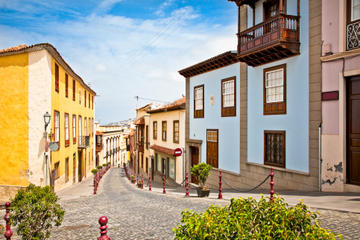 La Laguna
La Laguna La Laguna (or San Cristóbal de La Laguna) might have passed its role as capital over to Santa Cruz in 1723, but the lively student town remains one of Tenerife’s most important cities, linked by tram to Santa Cruz. Listed as a UNESCO World Heritage site in 1999, the Old Town of La Laguna
La Laguna
La Laguna La Laguna (or San Cristóbal de La Laguna) might have passed its role as capital over to Santa Cruz in 1723, but the lively student town remains one of Tenerife’s most important cities, linked by tram to Santa Cruz. Listed as a UNESCO World Heritage site in 1999, the Old Town of La Laguna
-
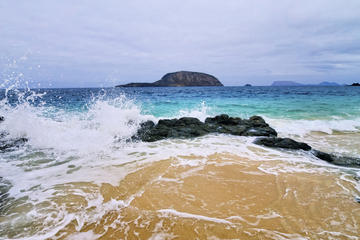 La Graciosa
La Graciosa Those looking a change of pace from the busy beach resorts and lively nightlife of mainland Lanzarote will find the tranquil isle of La Graciosa to be an enchanting place, just a short boat ride from the island’s northern coast. The largest and only inhabited inland of the small Chinij
La Graciosa
La Graciosa Those looking a change of pace from the busy beach resorts and lively nightlife of mainland Lanzarote will find the tranquil isle of La Graciosa to be an enchanting place, just a short boat ride from the island’s northern coast. The largest and only inhabited inland of the small Chinij
-
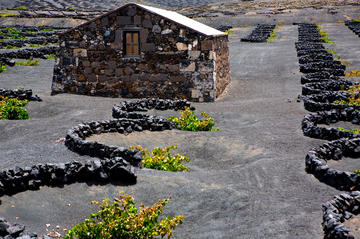 La Geria
La Geria Lanzarote’s rugged volcanic terrain might not seem like the ideal climate for wine growing, but the Canary Islands are renowned for their traditional cultivation of Malvasia grapes, producing the famous sweet Malmsey wine, among others. The La Geria district of Lanzarote has long been cel
La Geria
La Geria Lanzarote’s rugged volcanic terrain might not seem like the ideal climate for wine growing, but the Canary Islands are renowned for their traditional cultivation of Malvasia grapes, producing the famous sweet Malmsey wine, among others. The La Geria district of Lanzarote has long been cel
-
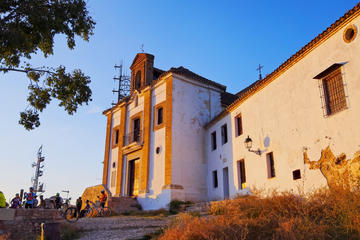 La Ermita de San Miguel Alto
La Ermita de San Miguel Alto Granada is hardly short on impressive lookout points, but when it comes to the one that rises above the rest — both literally and figuratively — La Ermita de San Miguel Alto wins the prize. Situated atop one of Granada’s northeastern hills, the tiny church offers views
La Ermita de San Miguel Alto
La Ermita de San Miguel Alto Granada is hardly short on impressive lookout points, but when it comes to the one that rises above the rest — both literally and figuratively — La Ermita de San Miguel Alto wins the prize. Situated atop one of Granada’s northeastern hills, the tiny church offers views
-
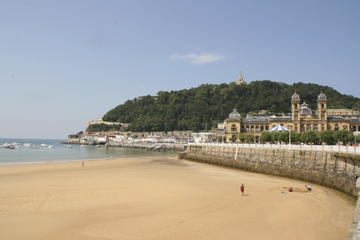 La Concha Beach (Playa de la Concha)
La Concha Beach (Playa de la Concha) San Sebastian’s main crescent-shaped beach is of softest sand and punctuated at both ends by craggy hills: Monte Urgull to the east and Monte Igueldo to the west. Translating into English as ‘the shell’, La Concha was fundamental in the incarnation of San Sebas
La Concha Beach (Playa de la Concha)
La Concha Beach (Playa de la Concha) San Sebastian’s main crescent-shaped beach is of softest sand and punctuated at both ends by craggy hills: Monte Urgull to the east and Monte Igueldo to the west. Translating into English as ‘the shell’, La Concha was fundamental in the incarnation of San Sebas
-
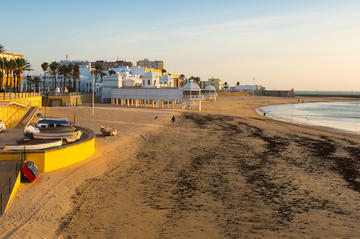 La Caleta Beach
La Caleta Beach Given that Cadiz is almost entirely surrounded by water, the desire to hit thebeach is bound to strike you at some point. When this happens, your go-to destination will be La Caleta, the only proper beach in old town. It’s an isolated shoreline that cozies up along the western side
La Caleta Beach
La Caleta Beach Given that Cadiz is almost entirely surrounded by water, the desire to hit thebeach is bound to strike you at some point. When this happens, your go-to destination will be La Caleta, the only proper beach in old town. It’s an isolated shoreline that cozies up along the western side
-
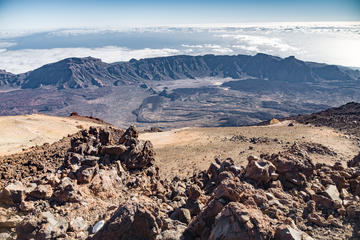 La Caldera
La Caldera Pine trees, volcanic geography, and views upon views are what you’ll find when exploring Tenerife’s La Caldera and the region that surrounds it. A volcanic crater, La Caldera is situated in La Orotava Valley, which spans the northern part of the island’s central coast. La Orotava is pac
La Caldera
La Caldera Pine trees, volcanic geography, and views upon views are what you’ll find when exploring Tenerife’s La Caldera and the region that surrounds it. A volcanic crater, La Caldera is situated in La Orotava Valley, which spans the northern part of the island’s central coast. La Orotava is pac
-
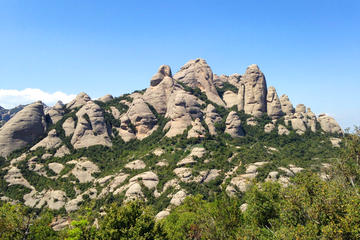 LEscolania de Montserrat
LEscolania de Montserrat Add listening to the ethereal choir songs of one of Europe’s oldest boys choirs to your list of reasons to explore the craggy Montserrat mountainside not far from Barcelona. The boys choir, which dates back to the 13th or 14th century, is not only historic but also world f
LEscolania de Montserrat
LEscolania de Montserrat Add listening to the ethereal choir songs of one of Europe’s oldest boys choirs to your list of reasons to explore the craggy Montserrat mountainside not far from Barcelona. The boys choir, which dates back to the 13th or 14th century, is not only historic but also world f
-
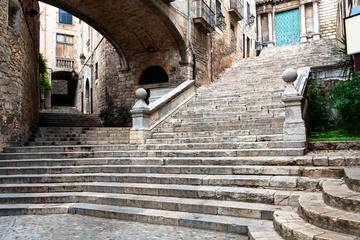 Jewish Quarter
Jewish Quarter Girona, easily one of Catalonia’s tourist destinations, is perhaps most famed for its Jewish quarter, also referred to as the Call. Considered one of the best-preserved Jewish quarters in the world, the Call dates back to the 12th century, when Girona was home to a thriving Jewish c
Jewish Quarter
Jewish Quarter Girona, easily one of Catalonia’s tourist destinations, is perhaps most famed for its Jewish quarter, also referred to as the Call. Considered one of the best-preserved Jewish quarters in the world, the Call dates back to the 12th century, when Girona was home to a thriving Jewish c
-
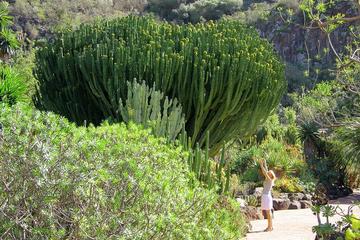 Jardin Botanico Canario Viera y Clavijo
Jardin Botanico Canario Viera y Clavijo A staple of Gran Canarian and Spanish culture, the botanical garden was named after pioneering Spanish cleric and scholar José Viera y Clavijo. It opened in 1959 after seven years of landscaping. And although it is intrinsically linked to the island’s histor
Jardin Botanico Canario Viera y Clavijo
Jardin Botanico Canario Viera y Clavijo A staple of Gran Canarian and Spanish culture, the botanical garden was named after pioneering Spanish cleric and scholar José Viera y Clavijo. It opened in 1959 after seven years of landscaping. And although it is intrinsically linked to the island’s histor
-
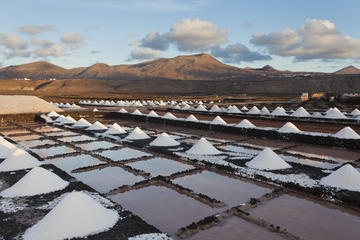 Janubio Salt Pans
Janubio Salt Pans Salt has played an important role in Lanzarote since the late 19th century, accounting for a large percentage of the island’s industrial income and even making its mark on local culture – during the traditional Corpus Christi festival, brightly-dyed salts are used to decorate the
Janubio Salt Pans
Janubio Salt Pans Salt has played an important role in Lanzarote since the late 19th century, accounting for a large percentage of the island’s industrial income and even making its mark on local culture – during the traditional Corpus Christi festival, brightly-dyed salts are used to decorate the
-
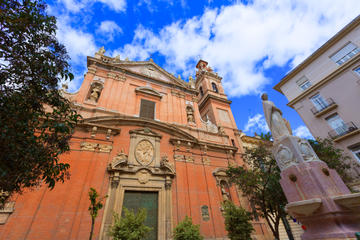 House of San Vicente Ferrer
House of San Vicente Ferrer Cities and regions across Spain have their own patron saints. In Valencia, one of those saints is none other than San Vicente Ferrer, who was born in this very city in the 14th century. It should come as no surprise, then, that his former “home” is a sacred spot for Cat
House of San Vicente Ferrer
House of San Vicente Ferrer Cities and regions across Spain have their own patron saints. In Valencia, one of those saints is none other than San Vicente Ferrer, who was born in this very city in the 14th century. It should come as no surprise, then, that his former “home” is a sacred spot for Cat
-
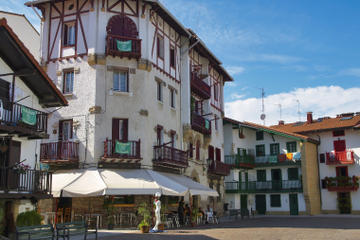 Hondarribia
Hondarribia The attractive walled Basque town of Hondarribia (Fuenterrabia in Spanish) sits on the banks of the River Bidasoa on Spain’s Atlantic coast 20 km (12.5 miles) east of San Sebastian. Considered one of the prettiest Basque coastal towns, Hondarribia is almost on the Atlantic border with
Hondarribia
Hondarribia The attractive walled Basque town of Hondarribia (Fuenterrabia in Spanish) sits on the banks of the River Bidasoa on Spain’s Atlantic coast 20 km (12.5 miles) east of San Sebastian. Considered one of the prettiest Basque coastal towns, Hondarribia is almost on the Atlantic border with
-
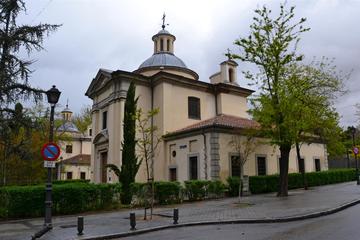 Hermitage of San Antonio de la Florida
Hermitage of San Antonio de la Florida Renowned across Spain for its magnificent frescos, the Hermitage of San Antonio de la Florida, or the Royal Chapel of St Anthony of Florida, is one of Madrid´s most popular churches. Built in 1792 by Italian architect Filippo Fontana under commission by Carlo
Hermitage of San Antonio de la Florida
Hermitage of San Antonio de la Florida Renowned across Spain for its magnificent frescos, the Hermitage of San Antonio de la Florida, or the Royal Chapel of St Anthony of Florida, is one of Madrid´s most popular churches. Built in 1792 by Italian architect Filippo Fontana under commission by Carlo
-
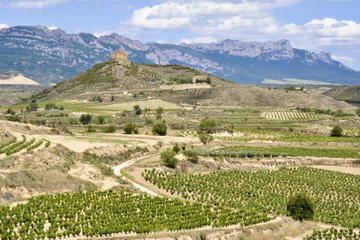 Haro
Haro The town of Haro is the wine capital of La Rioja region, known for its local red wine production and many bodegas. Its annual Haro Wine Festival draws in visitors from all over the world, and the climate, soil and infrastructures built by the French — who came to La Rioja to grow wine in the
Haro
Haro The town of Haro is the wine capital of La Rioja region, known for its local red wine production and many bodegas. Its annual Haro Wine Festival draws in visitors from all over the world, and the climate, soil and infrastructures built by the French — who came to La Rioja to grow wine in the
-
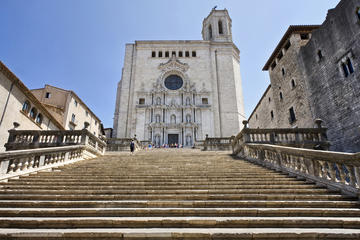 Girona Cathedral
Girona Cathedral There are many reasons to fall in love with Girona, but if there’s one thing — one sight — that will make your jaw actually drop, it will probably be the city’s main cathedral. That’s because its Baroque façade stands gloriously atop a massive staircase of some 90 steps. What you’
Girona Cathedral
Girona Cathedral There are many reasons to fall in love with Girona, but if there’s one thing — one sight — that will make your jaw actually drop, it will probably be the city’s main cathedral. That’s because its Baroque façade stands gloriously atop a massive staircase of some 90 steps. What you’
-
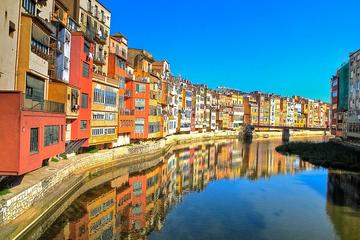 Girona
Girona Girona - also known as Gerona - has long stood at the crossroads of important trade routes, at the confluence of four rivers (the Ter, Onyar, Galligants and Güell), and between the Iberian Peninsula and France. Its mercantile wealth over the millennia is expressed in outstanding buildings,
Girona
Girona Girona - also known as Gerona - has long stood at the crossroads of important trade routes, at the confluence of four rivers (the Ter, Onyar, Galligants and Güell), and between the Iberian Peninsula and France. Its mercantile wealth over the millennia is expressed in outstanding buildings,
-
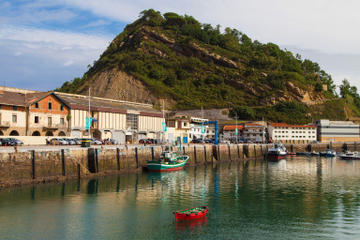 Getaria
Getaria Surrounded by two beaches on either side, it seems impossible not to slow down and enjoy the peaceful pace of this coastal Basque town. Take in the ocean views from the waterfront and from up the hills, taste freshly caught fish from the bay, or stroll through the well-preserved old town.
Getaria
Getaria Surrounded by two beaches on either side, it seems impossible not to slow down and enjoy the peaceful pace of this coastal Basque town. Take in the ocean views from the waterfront and from up the hills, taste freshly caught fish from the bay, or stroll through the well-preserved old town.
-
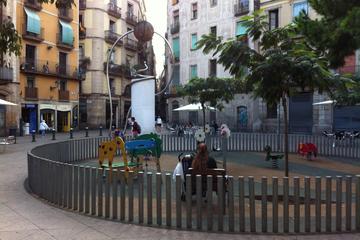 George Orwell Square
George Orwell Square Tucked away among the countless alleyways and courtyards of Barcelona’s atmospheric Barrio Gotico (Gothic Quarter) east of Las Ramblas, triangular George Orwell Square is named after the English author whose novel Homage to Catalonia was published in 1938 after he had spent si
George Orwell Square
George Orwell Square Tucked away among the countless alleyways and courtyards of Barcelona’s atmospheric Barrio Gotico (Gothic Quarter) east of Las Ramblas, triangular George Orwell Square is named after the English author whose novel Homage to Catalonia was published in 1938 after he had spent si
-
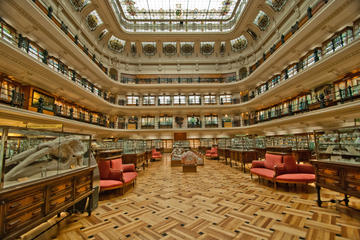 Geomining Museum (Museo Geominero)
Geomining Museum (Museo Geominero) This museum has nearly 10,000 rare fossils, minerals, corals and rocks on display. First commissioned by Queen Isabella in the 19th century, today it is run by the Spanish Institute of Geology and Mining as a public research facility. The museum features the mini
Geomining Museum (Museo Geominero)
Geomining Museum (Museo Geominero) This museum has nearly 10,000 rare fossils, minerals, corals and rocks on display. First commissioned by Queen Isabella in the 19th century, today it is run by the Spanish Institute of Geology and Mining as a public research facility. The museum features the mini
Total
2732 -travel
FirstPage PreviousPage NextPage LastPage CurrentPage:
7/137 20-travel/Page GoTo Page:
 La Laguna
La Laguna La Laguna (or San Cristóbal de La Laguna) might have passed its role as capital over to Santa Cruz in 1723, but the lively student town remains one of Tenerife’s most important cities, linked by tram to Santa Cruz. Listed as a UNESCO World Heritage site in 1999, the Old Town of La Laguna
La Laguna
La Laguna La Laguna (or San Cristóbal de La Laguna) might have passed its role as capital over to Santa Cruz in 1723, but the lively student town remains one of Tenerife’s most important cities, linked by tram to Santa Cruz. Listed as a UNESCO World Heritage site in 1999, the Old Town of La Laguna
 La Graciosa
La Graciosa Those looking a change of pace from the busy beach resorts and lively nightlife of mainland Lanzarote will find the tranquil isle of La Graciosa to be an enchanting place, just a short boat ride from the island’s northern coast. The largest and only inhabited inland of the small Chinij
La Graciosa
La Graciosa Those looking a change of pace from the busy beach resorts and lively nightlife of mainland Lanzarote will find the tranquil isle of La Graciosa to be an enchanting place, just a short boat ride from the island’s northern coast. The largest and only inhabited inland of the small Chinij
 La Geria
La Geria Lanzarote’s rugged volcanic terrain might not seem like the ideal climate for wine growing, but the Canary Islands are renowned for their traditional cultivation of Malvasia grapes, producing the famous sweet Malmsey wine, among others. The La Geria district of Lanzarote has long been cel
La Geria
La Geria Lanzarote’s rugged volcanic terrain might not seem like the ideal climate for wine growing, but the Canary Islands are renowned for their traditional cultivation of Malvasia grapes, producing the famous sweet Malmsey wine, among others. The La Geria district of Lanzarote has long been cel
 La Ermita de San Miguel Alto
La Ermita de San Miguel Alto Granada is hardly short on impressive lookout points, but when it comes to the one that rises above the rest — both literally and figuratively — La Ermita de San Miguel Alto wins the prize. Situated atop one of Granada’s northeastern hills, the tiny church offers views
La Ermita de San Miguel Alto
La Ermita de San Miguel Alto Granada is hardly short on impressive lookout points, but when it comes to the one that rises above the rest — both literally and figuratively — La Ermita de San Miguel Alto wins the prize. Situated atop one of Granada’s northeastern hills, the tiny church offers views
 La Concha Beach (Playa de la Concha)
La Concha Beach (Playa de la Concha) San Sebastian’s main crescent-shaped beach is of softest sand and punctuated at both ends by craggy hills: Monte Urgull to the east and Monte Igueldo to the west. Translating into English as ‘the shell’, La Concha was fundamental in the incarnation of San Sebas
La Concha Beach (Playa de la Concha)
La Concha Beach (Playa de la Concha) San Sebastian’s main crescent-shaped beach is of softest sand and punctuated at both ends by craggy hills: Monte Urgull to the east and Monte Igueldo to the west. Translating into English as ‘the shell’, La Concha was fundamental in the incarnation of San Sebas
 La Caleta Beach
La Caleta Beach Given that Cadiz is almost entirely surrounded by water, the desire to hit thebeach is bound to strike you at some point. When this happens, your go-to destination will be La Caleta, the only proper beach in old town. It’s an isolated shoreline that cozies up along the western side
La Caleta Beach
La Caleta Beach Given that Cadiz is almost entirely surrounded by water, the desire to hit thebeach is bound to strike you at some point. When this happens, your go-to destination will be La Caleta, the only proper beach in old town. It’s an isolated shoreline that cozies up along the western side
 La Caldera
La Caldera Pine trees, volcanic geography, and views upon views are what you’ll find when exploring Tenerife’s La Caldera and the region that surrounds it. A volcanic crater, La Caldera is situated in La Orotava Valley, which spans the northern part of the island’s central coast. La Orotava is pac
La Caldera
La Caldera Pine trees, volcanic geography, and views upon views are what you’ll find when exploring Tenerife’s La Caldera and the region that surrounds it. A volcanic crater, La Caldera is situated in La Orotava Valley, which spans the northern part of the island’s central coast. La Orotava is pac
 LEscolania de Montserrat
LEscolania de Montserrat Add listening to the ethereal choir songs of one of Europe’s oldest boys choirs to your list of reasons to explore the craggy Montserrat mountainside not far from Barcelona. The boys choir, which dates back to the 13th or 14th century, is not only historic but also world f
LEscolania de Montserrat
LEscolania de Montserrat Add listening to the ethereal choir songs of one of Europe’s oldest boys choirs to your list of reasons to explore the craggy Montserrat mountainside not far from Barcelona. The boys choir, which dates back to the 13th or 14th century, is not only historic but also world f
 Jewish Quarter
Jewish Quarter Girona, easily one of Catalonia’s tourist destinations, is perhaps most famed for its Jewish quarter, also referred to as the Call. Considered one of the best-preserved Jewish quarters in the world, the Call dates back to the 12th century, when Girona was home to a thriving Jewish c
Jewish Quarter
Jewish Quarter Girona, easily one of Catalonia’s tourist destinations, is perhaps most famed for its Jewish quarter, also referred to as the Call. Considered one of the best-preserved Jewish quarters in the world, the Call dates back to the 12th century, when Girona was home to a thriving Jewish c
 Jardin Botanico Canario Viera y Clavijo
Jardin Botanico Canario Viera y Clavijo A staple of Gran Canarian and Spanish culture, the botanical garden was named after pioneering Spanish cleric and scholar José Viera y Clavijo. It opened in 1959 after seven years of landscaping. And although it is intrinsically linked to the island’s histor
Jardin Botanico Canario Viera y Clavijo
Jardin Botanico Canario Viera y Clavijo A staple of Gran Canarian and Spanish culture, the botanical garden was named after pioneering Spanish cleric and scholar José Viera y Clavijo. It opened in 1959 after seven years of landscaping. And although it is intrinsically linked to the island’s histor
 Janubio Salt Pans
Janubio Salt Pans Salt has played an important role in Lanzarote since the late 19th century, accounting for a large percentage of the island’s industrial income and even making its mark on local culture – during the traditional Corpus Christi festival, brightly-dyed salts are used to decorate the
Janubio Salt Pans
Janubio Salt Pans Salt has played an important role in Lanzarote since the late 19th century, accounting for a large percentage of the island’s industrial income and even making its mark on local culture – during the traditional Corpus Christi festival, brightly-dyed salts are used to decorate the
 House of San Vicente Ferrer
House of San Vicente Ferrer Cities and regions across Spain have their own patron saints. In Valencia, one of those saints is none other than San Vicente Ferrer, who was born in this very city in the 14th century. It should come as no surprise, then, that his former “home” is a sacred spot for Cat
House of San Vicente Ferrer
House of San Vicente Ferrer Cities and regions across Spain have their own patron saints. In Valencia, one of those saints is none other than San Vicente Ferrer, who was born in this very city in the 14th century. It should come as no surprise, then, that his former “home” is a sacred spot for Cat
 Hondarribia
Hondarribia The attractive walled Basque town of Hondarribia (Fuenterrabia in Spanish) sits on the banks of the River Bidasoa on Spain’s Atlantic coast 20 km (12.5 miles) east of San Sebastian. Considered one of the prettiest Basque coastal towns, Hondarribia is almost on the Atlantic border with
Hondarribia
Hondarribia The attractive walled Basque town of Hondarribia (Fuenterrabia in Spanish) sits on the banks of the River Bidasoa on Spain’s Atlantic coast 20 km (12.5 miles) east of San Sebastian. Considered one of the prettiest Basque coastal towns, Hondarribia is almost on the Atlantic border with
 Hermitage of San Antonio de la Florida
Hermitage of San Antonio de la Florida Renowned across Spain for its magnificent frescos, the Hermitage of San Antonio de la Florida, or the Royal Chapel of St Anthony of Florida, is one of Madrid´s most popular churches. Built in 1792 by Italian architect Filippo Fontana under commission by Carlo
Hermitage of San Antonio de la Florida
Hermitage of San Antonio de la Florida Renowned across Spain for its magnificent frescos, the Hermitage of San Antonio de la Florida, or the Royal Chapel of St Anthony of Florida, is one of Madrid´s most popular churches. Built in 1792 by Italian architect Filippo Fontana under commission by Carlo
 Haro
Haro The town of Haro is the wine capital of La Rioja region, known for its local red wine production and many bodegas. Its annual Haro Wine Festival draws in visitors from all over the world, and the climate, soil and infrastructures built by the French — who came to La Rioja to grow wine in the
Haro
Haro The town of Haro is the wine capital of La Rioja region, known for its local red wine production and many bodegas. Its annual Haro Wine Festival draws in visitors from all over the world, and the climate, soil and infrastructures built by the French — who came to La Rioja to grow wine in the
 Girona Cathedral
Girona Cathedral There are many reasons to fall in love with Girona, but if there’s one thing — one sight — that will make your jaw actually drop, it will probably be the city’s main cathedral. That’s because its Baroque façade stands gloriously atop a massive staircase of some 90 steps. What you’
Girona Cathedral
Girona Cathedral There are many reasons to fall in love with Girona, but if there’s one thing — one sight — that will make your jaw actually drop, it will probably be the city’s main cathedral. That’s because its Baroque façade stands gloriously atop a massive staircase of some 90 steps. What you’
 Girona
Girona Girona - also known as Gerona - has long stood at the crossroads of important trade routes, at the confluence of four rivers (the Ter, Onyar, Galligants and Güell), and between the Iberian Peninsula and France. Its mercantile wealth over the millennia is expressed in outstanding buildings,
Girona
Girona Girona - also known as Gerona - has long stood at the crossroads of important trade routes, at the confluence of four rivers (the Ter, Onyar, Galligants and Güell), and between the Iberian Peninsula and France. Its mercantile wealth over the millennia is expressed in outstanding buildings,
 Getaria
Getaria Surrounded by two beaches on either side, it seems impossible not to slow down and enjoy the peaceful pace of this coastal Basque town. Take in the ocean views from the waterfront and from up the hills, taste freshly caught fish from the bay, or stroll through the well-preserved old town.
Getaria
Getaria Surrounded by two beaches on either side, it seems impossible not to slow down and enjoy the peaceful pace of this coastal Basque town. Take in the ocean views from the waterfront and from up the hills, taste freshly caught fish from the bay, or stroll through the well-preserved old town.
 George Orwell Square
George Orwell Square Tucked away among the countless alleyways and courtyards of Barcelona’s atmospheric Barrio Gotico (Gothic Quarter) east of Las Ramblas, triangular George Orwell Square is named after the English author whose novel Homage to Catalonia was published in 1938 after he had spent si
George Orwell Square
George Orwell Square Tucked away among the countless alleyways and courtyards of Barcelona’s atmospheric Barrio Gotico (Gothic Quarter) east of Las Ramblas, triangular George Orwell Square is named after the English author whose novel Homage to Catalonia was published in 1938 after he had spent si
 Geomining Museum (Museo Geominero)
Geomining Museum (Museo Geominero) This museum has nearly 10,000 rare fossils, minerals, corals and rocks on display. First commissioned by Queen Isabella in the 19th century, today it is run by the Spanish Institute of Geology and Mining as a public research facility. The museum features the mini
Geomining Museum (Museo Geominero)
Geomining Museum (Museo Geominero) This museum has nearly 10,000 rare fossils, minerals, corals and rocks on display. First commissioned by Queen Isabella in the 19th century, today it is run by the Spanish Institute of Geology and Mining as a public research facility. The museum features the mini